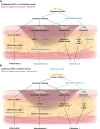Adipose-Derived Stem Cells for the Treatment of Diabetic Wound: From Basic Study to Clinical Application
- PMID: 35898452
- PMCID: PMC9309392
- DOI: 10.3389/fendo.2022.882469
Adipose-Derived Stem Cells for the Treatment of Diabetic Wound: From Basic Study to Clinical Application
Abstract
Diabetic wounds significantly affect the life quality of patients and may cause amputation and mortality if poorly managed. Recently, a wide range of cell-based methods has emerged as novel therapeutic methods in treating diabetic wounds. Adipose-derived stem cells (ASCs) are considered to have the potential for widespread clinical application of diabetic wounds treatment in the future. This review summarized the mechanisms of ASCs to promote diabetic wound healing, including the promotion of immunomodulation, neovascularization, and fibro synthesis. We also review the current progress and limitations of clinical studies using ASCs to intervene in diabetic wound healing. New methods of ASC delivery have been raised in recent years to provide a standardized and convenient use of ASCs.
Keywords: adipose-derived stem cells (ASC); cell therapy; diabetic ulcer; diabetic wound; diabetic wound healing.
Copyright © 2022 Liu, Dong, Chang, Liang and Wang.
Conflict of interest statement
The authors declare that the research was conducted in the absence of any commercial or financial relationships that could be construed as a potential conflict of interest.
Figures

Similar articles
-
[Preliminary evaluation and mechanism of adipose-derived stem cell transplantation from allogenic diabetic rats in the treatment of diabetic rat wounds].Zhonghua Shao Shang Za Zhi. 2019 Sep 20;35(9):645-654. doi: 10.3760/cma.j.issn.1009-2587.2019.09.002. Zhonghua Shao Shang Za Zhi. 2019. PMID: 31594182 Chinese.
-
Adipose stem cells isolated from diabetic mice improve cutaneous wound healing in streptozotocin-induced diabetic mice.Stem Cell Res Ther. 2020 Mar 17;11(1):120. doi: 10.1186/s13287-020-01621-x. Stem Cell Res Ther. 2020. PMID: 32183899 Free PMC article.
-
Low-glucose culture environment can enhance the wound healing capability of diabetic adipose-derived stem cells.Stem Cell Res Ther. 2023 Sep 4;14(1):236. doi: 10.1186/s13287-023-03478-2. Stem Cell Res Ther. 2023. PMID: 37667384 Free PMC article.
-
Adipose-derived Stem Cells for Treatment of Diabetic Foot Ulcers: A Review.Curr Stem Cell Res Ther. 2025;20(5):509-523. doi: 10.2174/011574888X334166240921120502. Curr Stem Cell Res Ther. 2025. PMID: 40525423 Review.
-
Implications of Extracellular Matrix Production by Adipose Tissue-Derived Stem Cells for Development of Wound Healing Therapies.Int J Mol Sci. 2017 May 31;18(6):1167. doi: 10.3390/ijms18061167. Int J Mol Sci. 2017. PMID: 28561757 Free PMC article. Review.
Cited by
-
Contemporary Review: The Use of Adipocyte-Derived Mesenchymal Stem Cells in Pathologies of the Foot and Ankle.Foot Ankle Orthop. 2023 Nov 2;8(4):24730114231207643. doi: 10.1177/24730114231207643. eCollection 2023 Oct. Foot Ankle Orthop. 2023. PMID: 37929076 Free PMC article. Review. No abstract available.
-
Current and promising applications of MOF composites in the healing of diabetes wounds.RSC Med Chem. 2024 May 17;15(8):2601-2621. doi: 10.1039/d4md00232f. eCollection 2024 Aug 14. RSC Med Chem. 2024. PMID: 39149100 Free PMC article. Review.
-
Study on the regulatory effect of Panax notoginseng saponins combined with bone mesenchymal stem cell transplantation on IRAK1/TRAF6-NF-κB pathway in patients with diabetic cutaneous ulcers.J Orthop Surg Res. 2023 Jan 31;18(1):80. doi: 10.1186/s13018-022-03467-w. J Orthop Surg Res. 2023. PMID: 36721171 Free PMC article.
-
Methylglyoxal Impairs the Pro-Angiogenic Ability of Mouse Adipose-Derived Stem Cells (mADSCs) via a Senescence-Associated Mechanism.Cells. 2023 Jun 28;12(13):1741. doi: 10.3390/cells12131741. Cells. 2023. PMID: 37443775 Free PMC article.
-
PLGA/Gelatin/Hyaluronic Acid Fibrous Membrane Scaffold for Therapeutic Delivery of Adipose-Derived Stem Cells to Promote Wound Healing.Biomedicines. 2022 Nov 11;10(11):2902. doi: 10.3390/biomedicines10112902. Biomedicines. 2022. PMID: 36428471 Free PMC article.
References
Publication types
MeSH terms
LinkOut - more resources
Full Text Sources
Miscellaneous

